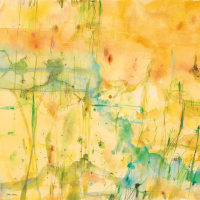51. JOHN OLSEN

John Olsen is widely regarded as one of Australias greatest living artists. His lyrical and organic visual language has for the past 60 years largely been devoted toward capturing our nations unique and varied natural environments. As the creator of impressive oil paintings, grand in scope and scale, his works are held in all major state and national galleries. Yet Olsen is equally as proficient with an etching needle on copper plate, or with ink, watercolour or pastel on paper. This is evidenced by his substantial oeuvre of graphic art that equates to over 400 original limited edition prints, and numerous other works on paper.
Working with watercolor clearly suits the loose linework and gestural manner that defines Olsens aesthetic. A fascination with Oriental art first led him to explore watercolour techniques, a medium spurned during his early studies at the Julian Ashton Art School by his then master John Passmore (1904-1984), who spoke of it in derisive terms as a technique for wealthy ladies.1 Yet what better choice of medium to capture Olsens calligraphic style of mark-making and his fascination with rivers, lakes and harbours, than one that relies on water itself as a vehicle for colour pigment.
The present work is based on the landscape of Rydal, a small town located roughly 150 kilometres west of Sydney, where the artist and his wife Katherine Howard moved in 1990. It contains many aesthetic qualities for which Olsens work is renowned. In it we see the artist reject the conventional view of the landscape with clearly defined foreground, middle-ground and background. Rather, multiple perspectives are incorporated into the scene, including an aerial view, to build a more experiential approximation of the artists encounters with the Little Creek at Rydal.
The present work also features a classic Olsen leitmotif, in the form of two green frogs that dance their way into the left hand side of the picture plane. Olsen has depicted these quirky amphibians with more frequency and vigour than any other Australian artist. They regularly appear in his work, imbued with a playful, energetic awkwardness slightly ridiculous but completely endearing. In many ways Olsens frogs manifest the artists celebratory and inherently optimistic conception of the natural world. They convey joy, while also signifying a landscape abundant with life.
Olsen considers the metamorphosis from tadpole to frog as one of these animals most intriguing facets.2 This mirrors the dramatic change that is found within certain Australian environments, as seasonal rains can completely transform dry barren terrain to verdant wetlands. Such is the case with Lake Eyre, one of Olsens most enduring subjects. He speaks of this rich environment, Everywhere you go is teeming with life, and the wriggling lines and dots form my rivers and rocks.3 Within the context of Olsens ongoing exploration of the Australian landscape, the frog, whose lifecycle depends on water, becomes a potent metaphor for life, growth and transformation.
In The Little Creek, Rydal the idea of water as life-giver is poetically conveyed in the blue stain that meanders through the composition, around which green vegetation and frogs abound. Olsen executes the delicate splayed-legged frogs in loose watercolour strokes, with a few well-placed darker lines to define their eyes and webbed feet. Against liquefied fields of pale earth colours, Olsen makes vigorous vertical stokes in pastel to indicate native flora. This combination of the dry and textured pastel against flowing stains of watercolour introduces an expressive quality to the otherwise subtly rendered scene.
All reflect Olsens sensual approach to art, which consciously rejects what he decries as its frequent over-intellectualisation.4 The results are unashamedly life-affirming, a quality which ensures the artists unique place in the spectrum of contemporary art.
1. McGregor, K., John Olsen: Drawing The Human Touch, Macmillan Art Publishing, Melbourne, 2014, p.13
2. Ibid, p.22
3. Olsen , J., quoted in interview with McGregor, K. John Olsen: Drawing The Human Touch, Macmillan Art Publishing, Melbourne, 2014, p.20
4. Zimmer, J. and McGregor, K., John Olsen: Journeys into the You Beaut Country, Macmillan Art Publishing, Melbourne, 2007, p.19
Marguerite Brown MA ArtCur